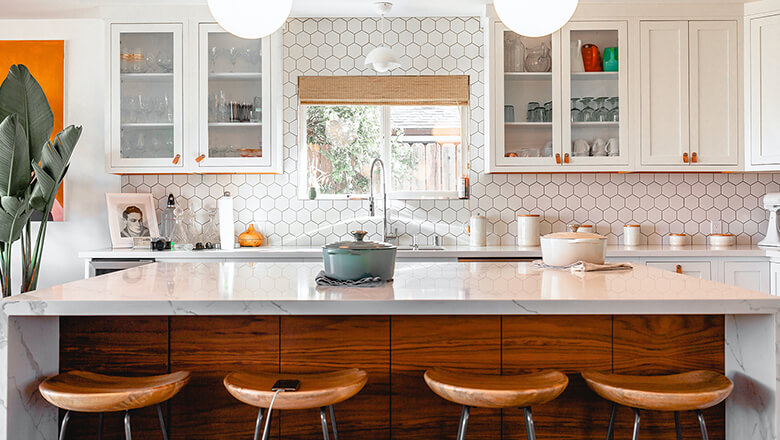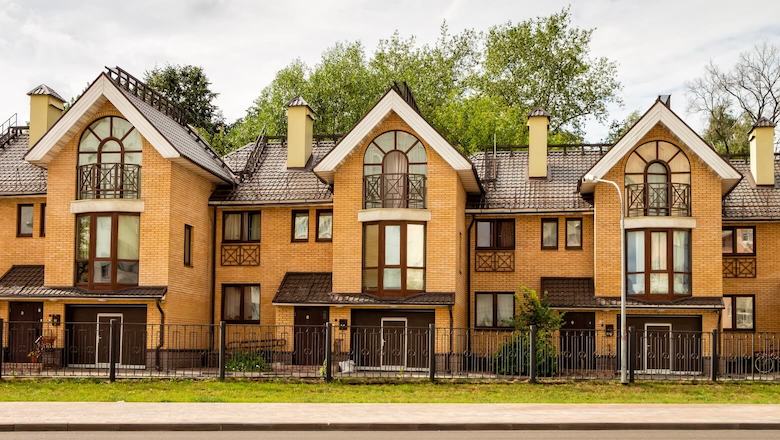How Much Does It Cost to Reface Cabinets?
Whether you’ve just moved into a new home or want to breathe new life into your current one, refacing cabinets in your kitchen could really transform the space.
Cabinet refacing involves changing the cabinet exterior surfaces only, and can cost significantly less than a full cabinet replacement. How much will it set you back? The cost to reface kitchen or bathroom cabinets ranges from roughly $4,000 to $10,000, with the national average coming in at around $7,000.
Read on to learn what factors affect refacing costs, how to keep a cabinet makeover project within your budget, and how to get started.
Average Cost of Cabinet Refacing
Cabinet refacing allows you to give your kitchen a refresh at a significantly lower price tag than a full kitchen remodel. The exact cost will depend on the materials you choose, the size of the room, labor costs, and where you live. However, the cost typically runs between $4,273 and $10,056, or an average of $7,158.
If you have a small kitchen, DIY the project, and choose budget-friendly materials, you could spend a lot less than the average cabinet refacing cost. On the other hand, if you have a large kitchen, hire a contractor, and go with top-of-the-line materials, you could spend significantly more.
Recommended: 20 Small Kitchen Remodel Ideas & Designs
Cabinet Makeover Costs by Budget
The good news is that you can give your cabinets a refresh on virtually any budget. Here’s a look at what you can accomplish at different price points.
Budget: Under $1,000
If you’re looking to spend less than $1,000, you can likely reface the cabinets in a small kitchen yourself using laminate veneers. However, you may need to keep the original hardware.
Budget: $1,000 to $5,000
With more wiggle room in your budget, you may be able to hire a contractor to reface your cabinets using laminate or wood veneer, and also replace the hardware. However, you may not be able to add accessories like a built-in wine rack or under-cabinet lighting.
Budget: $5,000 to $10,000
With this budget, you can likely hire a contractor to install high-end wood veneer and hardware, plus add cabinet accessories, even for a large kitchen. With a smaller space, you may be able to reface your cabinets with solid wood.
Budget: $10,000 to $15,000
If you can spend $10,000-plus on the project, you should be able to hire a contractor to install new solid wood doors and drawer fronts, choose luxurious hardware, and add fancy accessories. You might also be able to add a couple of custom cabinets to match your newly upgraded cabinets.
Recommended: 9 Ways to Keep Inflation From Ruining Your Kitchen Reno Budget
Reasons to Reface
Refacing old cabinets can give your kitchen an updated look for 30% to 50% less than a full cabinet replacement. This makes it an appealing option for homeowners looking to do a kitchen renovation on a budget. What’s more, there are a wide range of resurfacing options to choose from, so you can likely find a look that fits your kitchen design vision. The process is also faster and more environmentally friendly than a remodel.
Keep in mind, however, that refacing might not be the best option if the existing cabinets are damaged or you need a better kitchen layout. While refacing can make your kitchen look and feel brand new, it won’t change its layout or functionality.
Standard Options for Refacing
When you reface cabinets, there are four common types of finishes you can choose from. Here’s a look at each option.
Plastic Laminates
You can also reface cabinets with plastic laminate. The laminate is cut to size and applied to the cabinet boxes and doors using a special adhesive. This is one of most budget-friendly refacing options, ringing in between $1,000 and $3,000. However, plastic laminate is not as resistant to chipping and cracking as other refacing materials.
Wood Veneer
Wood veneers give you the look of wood cabinets without the high cost. They come in thin sheets designed to mimic standard species of wood, such as oak, cherry, maple, and ash, and run between $2,500 and $6,000. While wood veneer is stronger than laminate, it’s not as durable as real wood.
Rigid Thermofoil (RTF)
Rigid thermofoil laminate is another budget-friendly refacing choice. It’s made of plastic (Formica or melamine) but looks like wood and requires little care. Just keep in mind that the melamine version of RTF is not recommended for hot or humid environments. Refacing with RTS can run roughly $1,000 to $3,000.
Solid Wood
Solid wood refacing material is the priciest option but also the longest-lasting and easiest to repair. A solid wood refacing project can run anywhere from $5,000 to $10,000. However, the cabinets will look high-end and the doors and drawers will be extremely durable.
Other Factors that Affect the Cost of Refacing
When coming up with your budget for a cabinet makeover, there are some other costs and upgrades you may want to factor in. Here’s a look at add-ons that can level up your kitchen refresh.
• Hardware replacements Replacing all the hardware on your cabinets can cost anywhere from $100 and $1,000, depending on the material and style.
• Crown molding Depending on the materials used and the labor involved, installing crown molding can run around $700 to $2,100.
• Under-cabinet lighting Having strip, built-in, or puck lights installed under your cabinets can run $200 to $300 per light. If your budget is tight, you can get peel-and-stick lights for as little as $20 to $30.
• Glass If you want to add glass inserts to some, or all, of your kitchen cabinets, plan on spending an extra $100 to $300 per linear foot of glass you add.
• Handy accessories If you’re interested in adding some extras, such as a built-in spice rack, built-in wine rack, pull-out trash can, or a lazy Susan, you’ll need to add some additional funds to your refacing budget.
Getting Started
If you are ready to move forward with refacing, it can be a good idea to shop around and get estimates from at least three contractors.
As you interview potential installers, be sure to ask about their experience with cabinet refacing and if they’re insured and licensed. You may also want to ask the following questions:
• What kind of refacing material do you recommend for this area?
• How long will this project take?
• Can I use my cabinets as soon as you’re done?
• How long will the refacing last?
• Do you make any changes to the interior of the cabinets?
• Does the estimate include handles and drawer pulls?
• Will you remove the doors and drawers to work on them at your shop or do all the work at my home?
• Can you use hardware that I’ve already purchased?
• Can you add features like crown molding, under-the-cabinet lighting, or glass inserts?
• Do you offer a warranty, and if so, what does it include?
Recommended: 10 Steps for the Perfect Bathroom Remodel
Financing Your Home Improvement
While a cabinet makeover can give your kitchen a face-lift for an affordable price, you’ll still need to come up with a significant sum of cash to cover the cost of materials and labor. If you’re eager to get going but don’t have enough money on hand, you may be able to finance the project using a home improvement loan.
A home improvement loan is essentially a personal loan designed to be used to pay for home upgrades and renovations. Available through banks, online lenders, and credit unions, these loans are typically unsecured (meaning your home isn’t used as collateral to secure the loan). You also don’t need to have any equity built up in your home to be approved. Instead, the lender decides how much to lend to you and at what rate based on your financial credentials, such as your credit score, income, and how much other debt you have.
Once approved, you receive a lump sum of cash up front you can then use to cover the cost of refacing your cabinets. You repay the loan (plus interest) in regular installments over the term of the loan, which can range from five to seven years.
If you think a personal loan might work well for your cabinet makeover project, SoFi could help. SoFi’s home improvement loans offer competitive, fixed rates and a variety of terms. Checking your rate won’t affect your credit score, and it takes just one minute.
SoFi Loan Products
SoFi loans are originated by SoFi Bank, N.A., NMLS #696891 (Member FDIC). For additional product-specific legal and licensing information, see SoFi.com/legal. Equal Housing Lender.
Checking Your Rates: To check the rates and terms you may qualify for, SoFi conducts a soft credit pull that will not affect your credit score. However, if you choose a product and continue your application, we will request your full credit report from one or more consumer reporting agencies, which is considered a hard credit pull and may affect your credit.
Third-Party Brand Mentions: No brands, products, or companies mentioned are affiliated with SoFi, nor do they endorse or sponsor this article. Third-party trademarks referenced herein are property of their respective owners.
SOPL0623010
Read more



